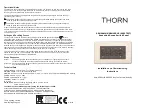
Network load control
10.2
Multicasts
116
UM Config GRS
Release
8.0
09/2019
10.2
Multicasts
By default, the device floods data packets with a Multicast address, that is, the device forwards the
data packets to every port. This leads to an increased network load.
The use of IGMP snooping can reduce the network load caused by Multicast data traffic. IGMP
snooping lets the device send Multicast data packets only on those ports to which devices
“interested” in Multicast are connected.
10.2.1
Example of a Multicast application
Surveillance cameras transmit images to monitors in the machine room and in the monitoring room.
With an IP Multicast transmission, the cameras transmit their graphic data over the network in
Multicast packets.
The Internet Group Management Protocol (IGMP) organizes the Multicast data traffic between the
Multicast routers and the monitors. The switches in the network between the Multicast routers and
the monitors monitor the IGMP data traffic continuously (“IGMP Snooping”).
Switches register logins for receiving a Multicast stream (IGMP report). The device then creates an
entry in the MAC address table (FDB) and forwards Multicast packets only to the ports on which it
has previously received IGMP reports.
10.2.2
IGMP snooping
The Internet Group Management Protocol (IGMP) describes the distribution of Multicast
information between routers and connected receivers on Layer 3. IGMP Snooping describes the
function of a switch of continuously monitoring IGMP traffic and optimizing its own transmission
settings for this data traffic.
The
IGMP Snooping
function in the device operates according to RFC 4541 (Considerations for
Internet Group Management Protocol (IGMP) and Multicast Listener Discovery (MLD) Snooping
Switches).
Multicast routers with an active
IGMP
function periodically request (query) registration of Multicast
streams in order to determine the associated IP Multicast group members. IP Multicast group
members reply with a Report message. This Report message contains the parameters required by
the
IGMP
function. The Multicast router enters the IP Multicast group address from the Report
message in its routing table. This causes it to forward data packets with this IP Multicast group in
the destination address field according to its routing table.
When leaving a Multicast group (IGMP version 2 and higher), receivers log out with a “Leave”
message and do not send any more Report messages. If it does not receive any more Report
messages from this receiver within a certain time (aging time), then the Multicast router removes
the routing table entry of a receiver.
When several IGMP Multicast routers are in the same network, the device with the smaller IP
address takes over the query function. When there are no Multicast routers on the network, you
have the option to enable the query function in an appropriately equipped switch.
A switch that connects one Multicast receiver with a Multicast router analyzes the IGMP information
with the IGMP snooping method.
Summary of Contents for GREYHOUND GRS1020
Page 8: ......
Page 16: ......
Page 146: ......
Page 232: ......
Page 310: ......
Page 330: ......
Page 338: ...Readers Comments 337 RM GUI GRS Release 8 0 09 2019 ...
Page 339: ......
Page 340: ......
Page 350: ......
Page 354: ......
Page 617: ...Readers Comments 277 UM Config GRS Release 8 0 09 2019 ...
Page 618: ......
Page 619: ......
















































